Key takeaways:
- Creativity in film combines imagination and storytelling, emphasizing the importance of engaging the audience through relatable emotions.
- Efficiency in filmmaking is crucial for managing time and enhancing the creative process, requiring structured planning and clear communication.
- Balancing creativity and efficiency involves dedicating time for brainstorming while navigating tight deadlines, allowing for both innovative ideas and coherent final products.
- Collaboration and adaptability play significant roles in enhancing creativity and ensuring that projects meet storytelling goals without compromising quality.

Understanding creativity in film
Creativity in film is a unique blend of imagination and storytelling. I remember my first project, where I had to visualize a complex narrative. The challenge of crafting compelling characters and dialogue sparked a realization: creativity is not just about wild ideas; it’s about bringing those ideas to life in a way that resonates with the audience.
As filmmakers, we often grapple with the question: how far can I push my creative boundaries while still engaging the viewer? In my experience, the answer often lies in the details. I learned that even small creative choices, like lighting or sound design, can fundamentally alter the mood of a scene. This taught me that every element contributes to the film’s overall narrative, making creativity an intricate web of interconnected decisions.
Balancing originality with audience expectations can be daunting. I recall a time when I tried to integrate an unconventional storytelling method, only to struggle with viewer comprehension. That experience taught me that creativity must be tempered with clarity. Sometimes, the most innovative concepts thrive when they are rooted in relatable emotions, ensuring that the audience not only understands but feels the story being told.
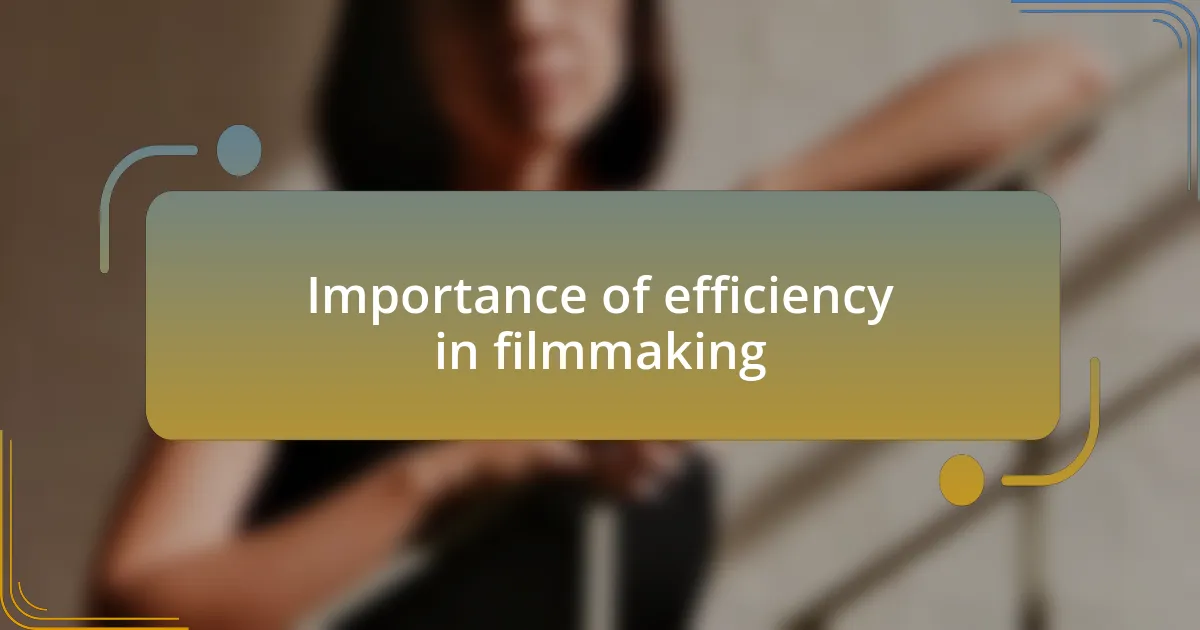
Importance of efficiency in filmmaking
Efficiency is a cornerstone of successful filmmaking. I remember a tight schedule on my first short film; it was a whirlwind of planning and execution. I learned that time management not only helps minimize stress but also allows for more creative freedom—when every minute counts, decisions must be made swiftly and confidently.
Working on set, I discovered how crucial efficient workflows are during production. One day, we spent far too long setting up a shot, and I could feel the frustration mounting. This eye-opening moment highlighted that smooth communication and well-defined roles could enhance productivity, freeing up time to focus on what truly matters: the art of storytelling. How can we truly bring our visions to life if we’re constantly battling the clock?
Post-production equally demands efficiency. I vividly recall a project where we rushed through editing, leading to a final product that didn’t fully capture our initial vision. This taught me to embrace a structured approach to editing—balancing speed with the meticulous attention that film often requires. In my experience, efficiency doesn’t stifle creativity; it sets the stage for it to flourish within the constraints we face.
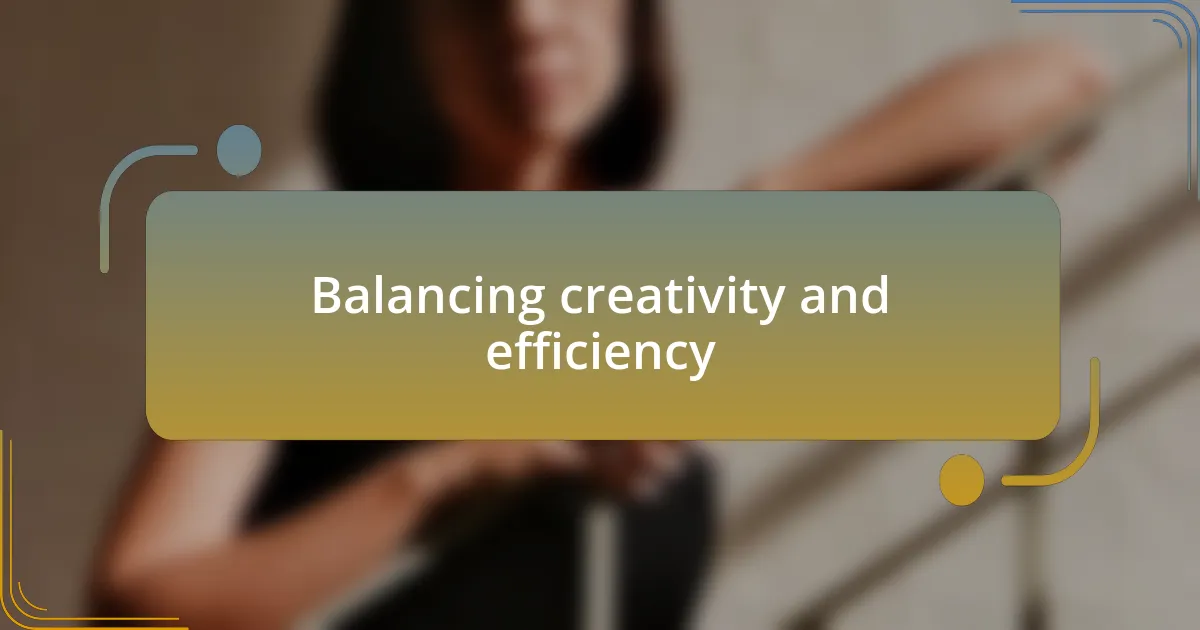
Balancing creativity and efficiency
Finding the right balance between creativity and efficiency in filmmaking can be a real juggling act. I recall working on a project where we had an innovative concept, but as we raced against the clock, some of those brilliant ideas got pushed aside. It made me wonder: how often do we let the urgency of deadlines silence our creative instincts? In my view, striking a harmonious balance means setting aside dedicated time for brainstorming and exploration, even when the pressure is on.
One day on set, I experimented with a technique I was excited about, only to realize we were running short on time. I felt a wave of anxiety wash over me, thinking I should prioritize speed over creativity. But when I took a moment to reevaluate, I discovered that integrating my creative instincts—the unique shot composition I envisioned—while simultaneously streamlining our work process led to a more coherent final product. This taught me that efficiency doesn’t have to quash creativity; rather, it can serve as a framework within which creativity can truly shine.
Reflecting on editing processes, I often noticed that rushing through the cuts led to missed opportunities for impact. During a frantic editing session, I nearly bypassed a poignant moment that could elevate the emotional depth of the film. It struck me how critical it is to respect both the creative process and the timeline; it’s possible to speed up without sacrificing the soul of your work. This dance between the two can ultimately enhance the storytelling, making the film not just efficient but deeply engaging.
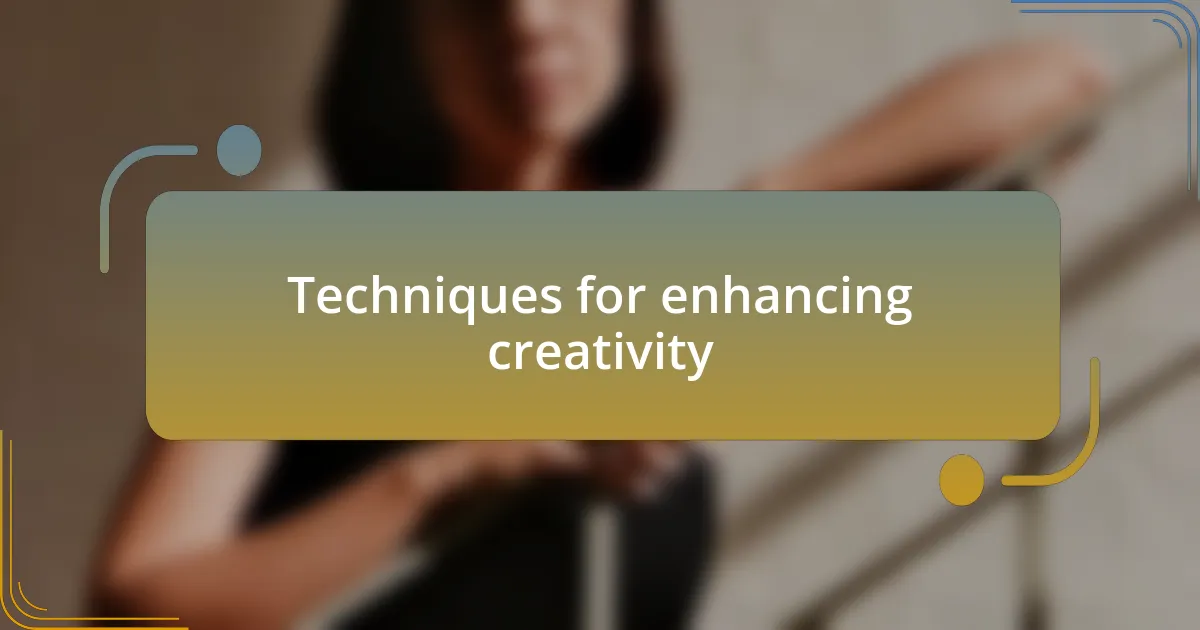
Techniques for enhancing creativity
One effective technique I’ve found for enhancing creativity is to embrace playfulness during brainstorming sessions. I remember a particular workshop where we threw around ridiculous ideas without judgment. It felt liberating to toss out concepts that, at first, seemed absurd. This kind of open-minded environment can spark unexpected connections that lead to unique solutions. Isn’t it fascinating how a little freedom can unlock innovative thinking?
Another approach involves changing your environment. I often work in different locations—whether it’s a cozy café or a bustling park—hoping to kickstart my creative juices. Each setting offers distinct sounds and visuals that can inspire fresh ideas. During one outdoors session, the lively atmosphere ignited a storyline that I hadn’t considered before. Sometimes, stepping out of your usual space can shift your perspective in ways that are truly profound.
Lastly, I’ve found that collaboration can significantly enhance creativity. Bringing in different viewpoints often leads to richer narratives. For example, during a recent project, I reached out to a colleague with a contrasting style. Their insights challenged my initial thoughts, pushing me to explore angles I hadn’t previously considered. Have you ever wondered how new ideas emerge when diverse minds come together? In my experience, the result is often a captivating blend of styles that elevates the final product.
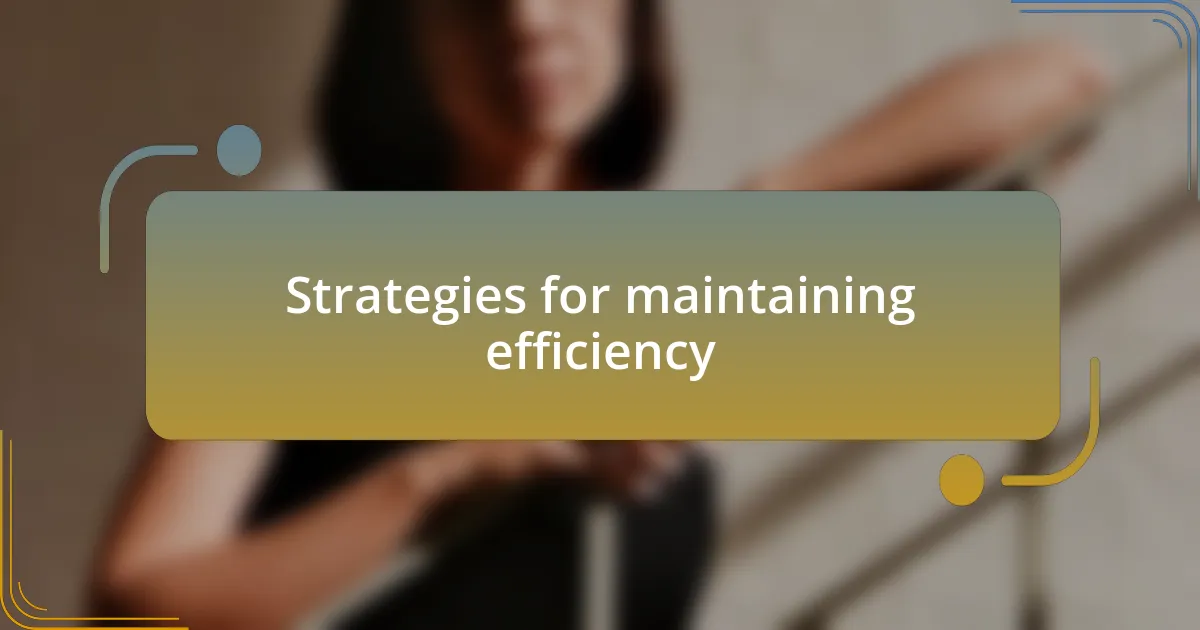
Strategies for maintaining efficiency
Maintaining efficiency in the film industry often requires some structured planning. I remember when I started managing a tight production schedule; it became imperative to break down tasks into smaller, achievable milestones. This helped me tackle overwhelming projects step by step. Have you ever felt flooded with ideas and tasks? Creating checklists transformed chaos into clarity for me, allowing progress to unfold steadily.
Another strategy is the use of technology to streamline processes. I once discovered a project management tool that helped my team track our progress in real-time. It’s remarkable how such digital resources can eliminate redundancy and reduce miscommunication. In fact, setting up reminders for each phase of production ensured my focus remained razor-sharp throughout the project.
Lastly, I’ve learned the importance of regular feedback loops. After my first few projects, I realized that gathering input from team members periodically could spotlight inefficiencies early on. This practice not only fostered a sense of collaboration but also kept everyone aligned with our goals. Have you considered how revisiting your work during its evolution can enhance both productivity and results? In my experience, these touchpoints have often led to smoother transitions and better-quality outcomes.
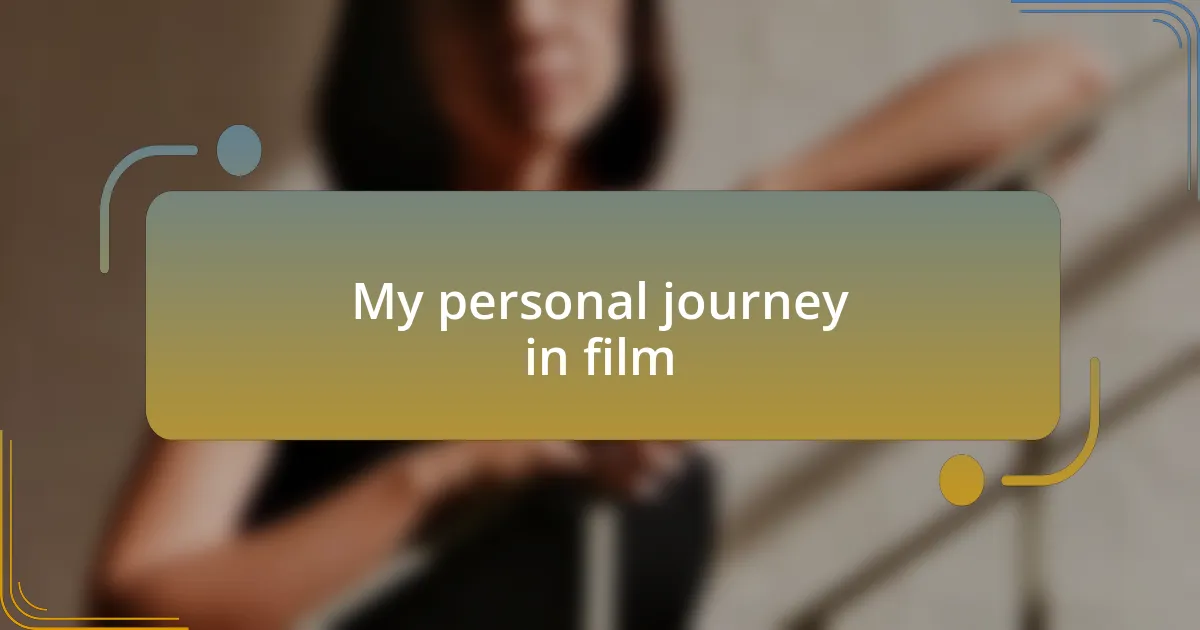
My personal journey in film
In my journey through the film industry, I vividly recall my first day on set, filled with anticipation and a touch of anxiety. The vibrant energy was palpable, yet I felt lost among the bustling crew and complex machinery. Have you ever been thrust into a situation where you had to learn on the fly? For me, it was in that chaotic environment that I discovered the delicate balance between creativity and efficiency, forging the path for my future projects.
As I transitioned from being a novice to taking on key roles, I realized that storytelling is not just about the script but about managing the visions of many. I distinctly remember working on a short film where we had only two days to shoot a scene that required intricate choreography and emotional depth. It was in those high-pressure moments that I learned to trust my instincts and be adaptive, to weave creativity into the rigid structure of time constraints. Isn’t it fascinating how sometimes the most profound creativity emerges from tight deadlines?
Over the years, I’ve embraced my mistakes as essential lessons rather than setbacks. Each film project taught me the importance of collaboration; a memorable instance was when I accidentally overlooked a key element during editing. This oversight led to an unexpected brainstorming session with the crew, resulting in a much richer narrative. Have you ever encountered a stumbling block that turned into a breakthrough? These experiences reinforced my belief that creativity thrives on teamwork and that efficiency should never come at the cost of a compelling story.
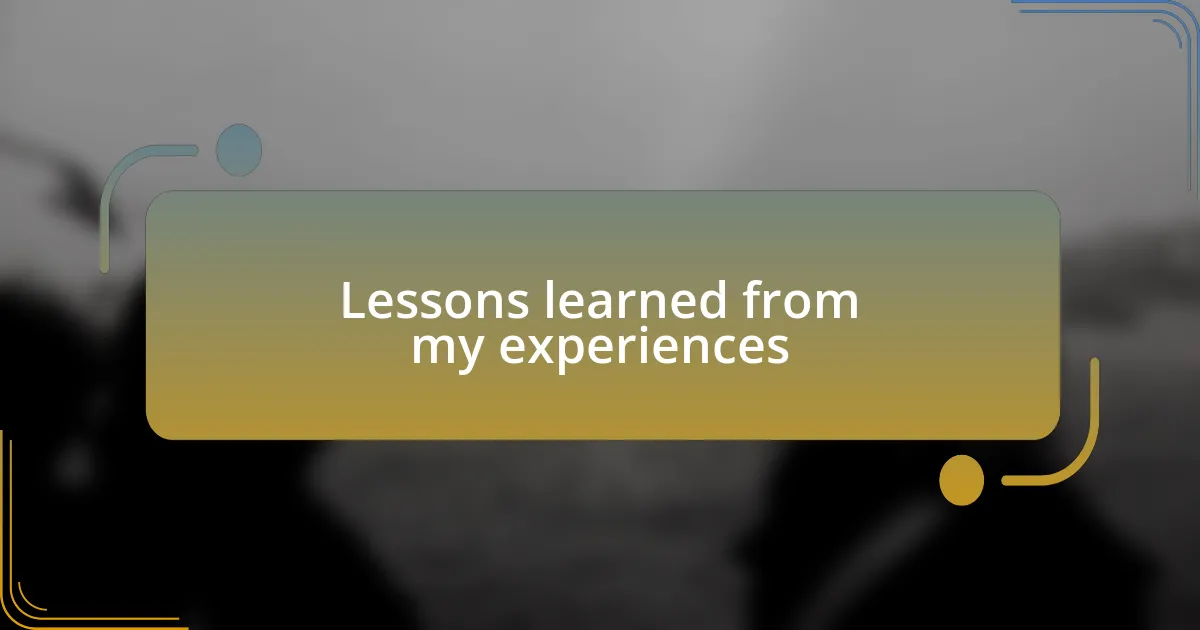
Lessons learned from my experiences
One of the most valuable lessons I’ve learned is the art of prioritizing tasks without sacrificing vision. I remember a project where we had a limited budget, and I had to decide between investing in props or hiring an experienced cinematographer. Opting for the cinematographer transformed our visuals and taught me that sometimes, efficiency doesn’t mean cutting corners but rather focusing on what truly enhances the story. Have you ever faced a similar choice where you had to weigh immediate needs against long-term impact?
I often reflect on how failure has played a significant role in my growth. Early on, I finished a short film that I was incredibly proud of, only to realize that the pacing was off. Instead of wallowing in disappointment, I reached out to my mentors for feedback. Their insights opened my eyes to the nuances of pacing and timing, making me appreciate how constructive criticism can be fuel for improvement. Don’t you think that embracing feedback can sometimes feel liberating, even if it stings at first?
Another lesson that stands out to me is the importance of flexibility in both thought and execution. I once worked on a screenplay where my initial idea was met with skepticism from my peers. Rather than sticking rigidly to my first vision, I chose to keep an open mind, and through collaborative discussions, we crafted a far more compelling narrative. This taught me that in the creative process, adaptability can lead to unexpected and enriching outcomes. Have you found that shifting your viewpoint opens up new avenues of innovation?